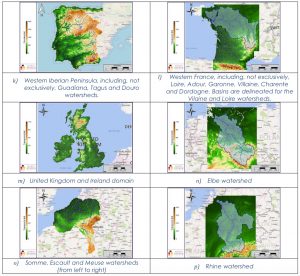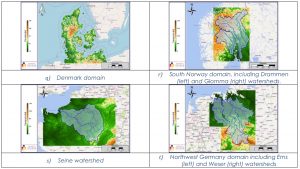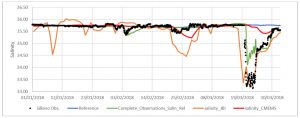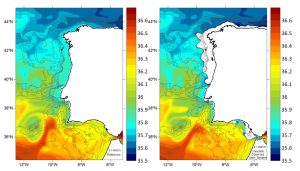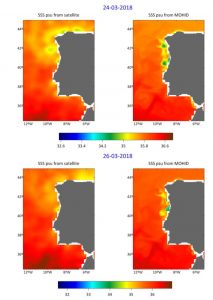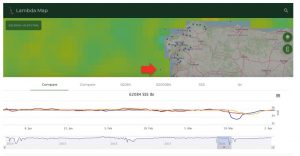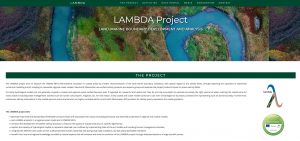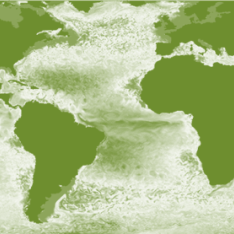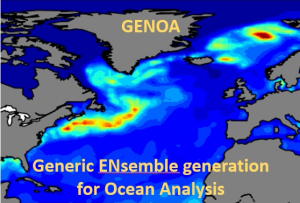LAMBDA PROJECT (λ) – LAND-MARINE BOUNDARY DEVELOPMENTS AND ANALYSIS
PI and organization: R. Neves (MARETEC-IST)
Co-Is: F. Campuzano, A. I. Oliveira, L. Simionesei (MARETEC-IST)
F. Braunschweig, D. Brito (Action Modulers)
A. Turiel, E. Olmedo (BEC-ICM)
A. Novellino, G. Manzella, A. Paolo (ETT)
The LAMBDA project main aim was to improve the CMEMS MFCs thermohaline circulation in coastal areas by a better characterisation of the land-marine boundary conditions, with special regard to the salinity fields, through exploring the capacities of watershed numerical modelling and its coupling to mesoscale regional ocean models. New Earth Observation (EO) sea surface salinity products and experts’ groups evaluated the project products impact on ocean salinity fields.
Currently, coupling hydrological models to coastal and regional ocean models is not a general practice because, even if regarded as a powerful and useful tool, they do not fully accomplish to estimate accurately the right volume of water reaching the coastal zone for many reasons including water management activities such as human consumption, irrigation, etc. For this reason, many coastal and ocean models continue to use river climatology as boundary conditions for representing such an active boundary. Furthermore, continuous salinity observations in the coastal area are scarce and sensors are highly unreliable while current EO products for salinity poorly represents the coastal gradients.
The LAMBDA project focused on:
- generating improved and standardised freshwater products flows and associated river inputs (including particulate and dissolved properties) in regional and coastal models;
- testing LAMBDA products in a regional ocean model applications and in CMEMS MFCs;
- enhancing the development of satellite salinity products to improve the quality of coastal products (i.e. specific algorithms);
- exploring the capacity of hydrological models to represent observed river outflows by implementing state-of-the-art models and including human management activities;
- integrating the different time scales of river outflow (extreme events, flood-ebb and spring-neap tidal conditions, dry-wet years) by flexible interfaces;
- benefitting from local and regional knowledge provided by coastal experts that will evaluate and drive the evolution of the LAMBDA project through dedicated sessions in large scientific events.
The LAMBDA project successfully relied on three pillars:
- A wide consortium with partner excellence on their respective area;
- Model, software and EO products developers connected with local experts on their corresponding coastal zone and with CMEMS MFCs operators;
- Communication activities to enhance data visualisation and partner interaction that enriched the LAMBDA products development.
In order to transfer effectively the LAMBDA project results to the CMEMS products the following strategy was designed: land-boundary conditions obtained from the defined scenarios will be applied and evaluated using the Portuguese Coast Operational Modelling System (hereafter referred as PCOMS, Mateus et al., 2012, Campuzano, 2018) for a two-year period and afterwards selected periods will be applied in the CMEMS MFCs. By following this approach, by the end of the project, at least one LAMBDA scenario will be tested at the CMEMS MFCs scale.
The LAMBDA team has identified three main outcomes: numerical modelling of the water continuum (from watershed to open ocean), coastal enhanced sea surface salinity earth observation product and LAMBDA data/product visualisation, exploration and comparison web portal. Please find below a brief description of the methodologies applied and some of the obtained results for each product.
Numerical Modelling of Water continuum: from watershed to open ocean:
The MOHID Land model, part of the MOHID Modelling System (http://www.mohid.com; Neves, 2013) is the numerical model used to simulate the water contributions in the study areas (IBI and NWS MFCs). The numerical model is open source and its code can be accessed in the following
GitHub repository (https://github.com/Mohid-Water-Modelling-System/Mohid). MOHID Land is a physically based, spatially distributed, continuous, variable time step model for the water and property cycles in inland waters. For the LAMBDA project, the MOHID Land model calculated river flow and water temperature. However, it is capable to estimate other associated water properties such as oxygen, sediments and nutrient concentrations.
The main goal was estimating the amount of freshwater entering the coastal areas of the North Sea/Atlantic Ocean. The LAMBDA project divided the study area into ten numerical modelling domains (Figure 1) using a regular grid with a horizontal resolution of 0.05 x 0.05 degrees (≈ 5×5 km). Each domain modelled for a period of 11 years (01/01/2008 – 01/01/2019) forced with ERA5 reanalysis obtained from Copernicus Climate Change Service (https://climate.copernicus.eu/). These simulations resulted in the LAMBDA Watershed product V1 that includes flow and temperature for a total of 54 main rivers near its mouth. As a special request from associated partners, 70 extra discharges for Western Iberia and 364 extra discharges for Ireland and UK domain were extracted to obtain a more comprehensive freshwater budget.
Figure 1. Watersheds included in Lambda.
In the LAMBDA project, a proxy to include the estuarine mixing processes including the estuary size, river discharge and local tidal conditions was developed based in a simple application of MOHID Water. The adaptation of the estuarine proxy to each estuary requires gathering some basic properties related with estuary geometry and geographical location. The proxy is forced by tides and water properties on the ocean boundary and river discharges in the land boundary. The proxy produces timeseries of water temperature, salinity, flow and velocity (u or v according to the estuary mouth orientation) estimated near the open ocean. The obtained velocity serves to add momentum to the estuarine plume in the regional ocean model. In contrast with river discharges, modelled estuarine flows have positive and negative values according to the tides phase (ebb and flow periods). The receiving model should allow negative discharges to fully include this type of open boundary. This estuarine proxy was validated using the Tagus and Douro estuaries as case studies and configuration was provided for 13 major European estuaries.
The LAMBDA boundary products were implemented first as proof of concept (PoC) in an updated version Portuguese Coast Operational Modelling System (hereafter referred as PCOMS, Mateus et al., 2012; Campuzano, 2018) that covers the western Iberia regional ocean for the period October 2017-December 2018. PCOMS is a 3D full baroclinic hydrodynamic and biogeochemical regional ocean operational model application that uses MOHID Water as its numerical core. This model application covers the West Iberia region comprised by the range of latitudes (34.38N, 45.00N) and longitudes (5.10W, 12.60W) with a horizontal resolution of 0.06o. The PCOMS uses as initial and boundary conditions the CMEMS Global Ocean 1/12° Physics Analysis and Forecast updated Daily (GLOBAL_ANALYSIS_FORECAST_PHY_001_024) and the CMEMS Global Ocean Biogeochemistry Analysis and Forecast (GLOBAL_ANALYSIS_FORECAST_BIO_001_028). These products are relaxed in the boundary (10 first cells) and no-assimilation is done in the inner area so the model can be considered as running free in the area affected by rivers. Tides in the current configuration are forced continuously along the top domain using the global tide solution FES2014 (Carrère et al., 2016).
Several land boundary scenarios where defined in the LAMBDA project to evaluate the impact of the different products and configurations on the ocean waters. To illustrate the LAMBDA project impact only two PCOMS scenarios are shown:
- Reference: model running from 2017 continuously without any land boundary input so it can be regarded as the baseline for river impacts. CMEMS Global Ocean Physics and Biogeochemistry relaxed at the open boundary, no river discharges;
- Complete Observations Salin_Related: This scenario used what can be regarded as the best forcing conditions consisting of a combination of observed data corrected by estuarine proxy at 6 estuaries (Minho, Douro, Mondego, Tagus, Sado and Guadalquivir) plus other 45 direct discharges using LAMBDA_V1 modelled flow and temperature. Direct discharge salinity is obtained from the Minho estuary proxy;
In this region, in addition to reliable river flow data, the number of rivers is a relevant feature. The concentration of river mouths in North-western Iberian coastal zone leads to a low salinity water lens (S < 35.8), referred as Western Iberia Buoyant Plume (WIPB), that extends along the coast and has been observed all-year-round, despite the seasonal runoff variation (Peliz et al., 2002). This plume can influence the water quality of surrounding waters and can be detected eventually in the salinity and temperature records of the Puertos del Estado Silleiro Buoy (6200084 in CMEMS in situ catalogue) located 50 km offshore of the coast (Figure 2; Campuzano, 2018). In this assessment, we focused on the first quarter of 2018 to observe the response of the PCOMS model to the LAMBDA scenarios during the wet season that includes an extreme event.
The LAMBDA PCOMS scenario (Complete Observations Salin_Related) reproduce the intensity and time extension of the biggest event while it avoids other salinity drops that are not observed by the Silleiro buoy (Figure 2). For comparison, CMEMS Global and IBI models are also included at Silleiro buoy. CMEMS Global results clearly underestimate the largest freshwater event. IBI MFC obtains good results for the extreme event however it overestimates other earlier events. The horizontal extension of the river influence can be seen in Figure 3.
Figure 2. Sea surface salinity at the Silleiro buoy during the first quarter of 2018 observed by the buoy and LAMBDA modelling scenario using using the 6 estuarine proxy plus 45 direct discharges as land boundary conditions. Surface salinity from Global CMEMS and IBI-MFC products are also included.
Figure 3. PCOMS average surface salinity for the 21st of March 2018 for the Reference scenario (left) and Complete Observations Salin_Rel (Right). White areas indicate salinity below 35.5. Silleiro buoy location indicated with a red dot.
Coastal enhanced Sea Surface Salinity Earth Observation product
From the EO perspective a new SMOS SSS global product was generated for the period 2011- 2019 with good performances in comparison with ARGO floats and other satellite products. The SMOS LAMBDA product V2 focussed in the mitigation of the coastal bias and the generation of a L4 SMOS SSS product that allows downscaling the salinity by using as a template the Sea Surface Temperature (SST) at 0.05o from OSTIA.
We have performed an extensive quality assessment of this product consisting of two different parts. On the one hand we have assessed the global performances of the product by comparing with ARGO floats, other satellite products and reanalysis. We have used as metrics statistics of differences with respect to in situ to assess the biases and standard deviation of the differences, triple collocations to provide maps of the estimation of the errors, singularity analysis and power density spectre to assess the effective resolution of the product. The main conclusions are that the SMOS LAMBDA product presents a very competitive global performance.
The coastal assessment shows that:
- The residual bias in the coastal pixel has been significantly mitigated in SMOS LAMBDA productV2
- Better description of coastal salinity dynamicso Seasonal and annual anomalies are consistent with modelling results
o The new product represents better the main rivers ́ plumes (Figure 4)
Figure 4. Daily Sea surface salinity for 24th of March 2018 (Top) and 26th of March 2018 (Bottom) from the BEC- SMOS Global L4 V2 (Left) and surface layer of PCOMS with LAMBDA Complete Observations boundary conditions.
LAMBDA data/product visualisation, exploration and comparison web portal:
The LAMBDA Data Portal is available @ http://www.cmems-lambda.eu/mapviewer/. For the data portal developed features, see section 2. The website is developed using C#, ASP.net 4.5 and JQuery for the front-end and Highcharts library (https://www.highcharts.com/) for charts rendering. Data and metadata are stored in a MS SQLServer 2012 database and WMS (Web Map Service) are provided by a specific GeoServer implementation. The data ingestion module is a standard C# multithread console application.
The LAMBDA project products web interface (Figure 5) is a simple user interface that provides the users with visualization tool for timeseries of runoff data from predefined stations (real or virtual – i.e. LAMBDA Proxy Product), it presents the LAMBDA SSS SMOS products and allow the user to both explore the SSS product and compare satellite data with in situ data. It also allows the user to compare the LAMBDA SSS SMOS data with CMEMS 005_002 and download the comparison for the given position.
The LAMBDA portal hosts the following products: LAMBDA Watershed V1, LAMBDA PROXY V.2.0, IN SITU NRT RIVER RUNOFF, LAMBDA SSS (SMOS), IN SITU PSAL and CMEMS IBI REANALYSIS PHYS 005 002. The default view includes LAMBDA SSS (SMOS), LAMBDA PROXY V.2.0, and IN SITU NRT RIVER RUNOFF.
Figure 5. Product comparison and assessment on the portal for a given position (i.e. the Silleiro buoy). The user must select the Salinity SSS + IN SITU PSAL layers from the menu on the left. The system loads the SSS SMOS (V2.0 L3), CMEMS MY 005 002, IN SITU Stations with PSAL data. When the user selects the buoy (triangles), the system loads for that given position, the timeseries from the loaded layers and shows both individual charts and the comparison plot. Form the plot tool it is possible to download the csv files and run more statistical tests for the assessment.
Brief conclusions
The LAMBDA project aimed to demonstrate the capacity of watershed modelling to improve land-marine boundary forcing and their impact on CMEMS MFC. The proposed methodology provided a comprehensive set of products and model results that CMEMS MFCs can now use as reference. The described methodology allows to obtain a more precise coastal circulation and to simulate the creation of salinity and temperature fronts and the nutrient coastal input in a more realistic approach.
LAMBDA developed new global EO SSS products adapted for the coastal regions that can serve for model validation/assimilation. An extensive quality assessment has been performed by comparing the performance of the new EO salinity products with the one of other existing satellite salinity products through a wide variety of validation methods.
Analysis and combination of several sources of information has been achieved by user-friendly data portal including the existing and developed salinity products. LAMBDA Products are accessible and downloadable from the LAMBDA web portal and web products page.
For more information about the project objectives, activities and consortium please visit http://www.cmems-lambda.eu. If you have further queries do not hesitate to contact Francisco Campuzano (campuzanofj.maretec@tecnico.ulisboa.pt).

